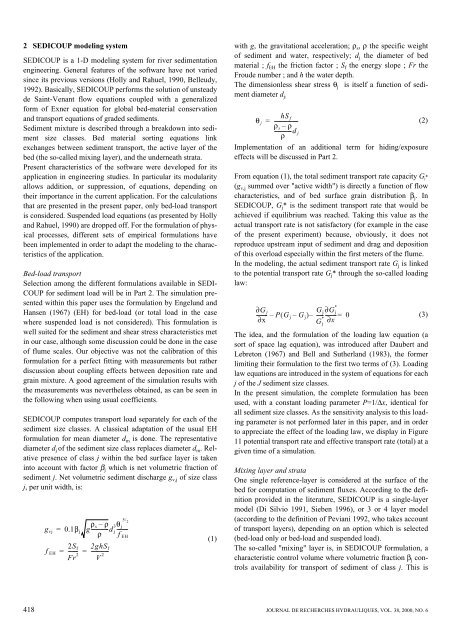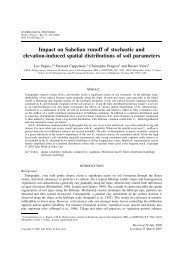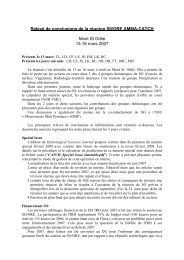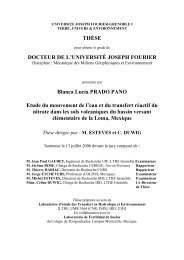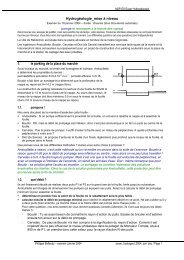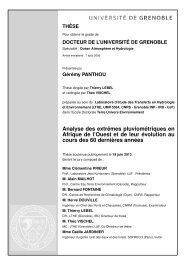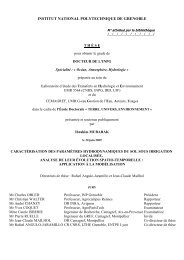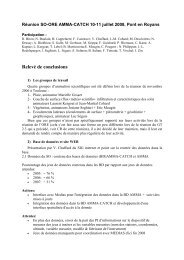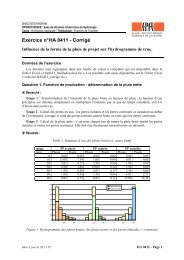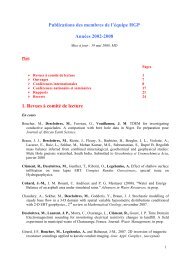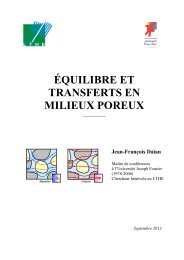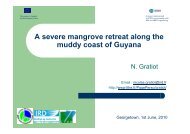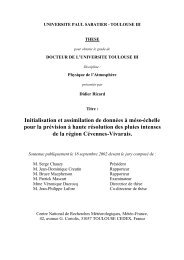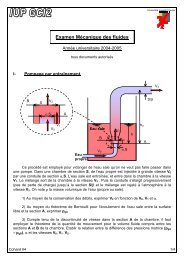Numerical simulation of sediment mixture deposition part 1 ... - LTHE
Numerical simulation of sediment mixture deposition part 1 ... - LTHE
Numerical simulation of sediment mixture deposition part 1 ... - LTHE
You also want an ePaper? Increase the reach of your titles
YUMPU automatically turns print PDFs into web optimized ePapers that Google loves.
2 SEDICOUP modeling system<br />
SEDICOUP is a 1-D modeling system for river <strong>sediment</strong>ation<br />
engineering. General features <strong>of</strong> the s<strong>of</strong>tware have not varied<br />
since its previous versions (Holly and Rahuel, 1990, Belleudy,<br />
1992). Basically, SEDICOUP performs the solution <strong>of</strong> unsteady<br />
de Saint-Venant flow equations coupled with a generalized<br />
form <strong>of</strong> Exner equation for global bed-material conservation<br />
and transport equations <strong>of</strong> graded <strong>sediment</strong>s.<br />
Sediment <strong>mixture</strong> is described through a breakdown into <strong>sediment</strong><br />
size classes. Bed material sorting equations link<br />
exchanges between <strong>sediment</strong> transport, the active layer <strong>of</strong> the<br />
bed (the so-called mixing layer), and the underneath strata.<br />
Present characteristics <strong>of</strong> the s<strong>of</strong>tware were developed for its<br />
application in engineering studies. In <strong>part</strong>icular its modularity<br />
allows addition, or suppression, <strong>of</strong> equations, depending on<br />
their importance in the current application. For the calculations<br />
that are presented in the present paper, only bed-load transport<br />
is considered. Suspended load equations (as presented by Holly<br />
and Rahuel, 1990) are dropped <strong>of</strong>f. For the formulation <strong>of</strong> physical<br />
processes, different sets <strong>of</strong> empirical formulations have<br />
been implemented in order to adapt the modeling to the characteristics<br />
<strong>of</strong> the application.<br />
Bed-load transport<br />
Selection among the different formulations available in SEDI-<br />
COUP for <strong>sediment</strong> load will be in Part 2. The <strong>simulation</strong> presented<br />
within this paper uses the formulation by Engelund and<br />
Hansen (1967) (EH) for bed-load (or total load in the case<br />
where suspended load is not considered). This formulation is<br />
well suited for the <strong>sediment</strong> and shear stress characteristics met<br />
in our case, although some discussion could be done in the case<br />
<strong>of</strong> flume scales. Our objective was not the calibration <strong>of</strong> this<br />
formulation for a perfect fitting with measurements but rather<br />
discussion about coupling effects between <strong>deposition</strong> rate and<br />
grain <strong>mixture</strong>. A good agreement <strong>of</strong> the <strong>simulation</strong> results with<br />
the measurements was nevertheless obtained, as can be seen in<br />
the following when using usual coefficients.<br />
SEDICOUP computes transport load separately for each <strong>of</strong> the<br />
<strong>sediment</strong> size classes. A classical adaptation <strong>of</strong> the usual EH<br />
formulation for mean diameter d m is done. The representative<br />
diameter d j <strong>of</strong> the <strong>sediment</strong> size class replaces diameter d m . Relative<br />
presence <strong>of</strong> class j within the bed surface layer is taken<br />
into account with factor β j which is net volumetric fraction <strong>of</strong><br />
<strong>sediment</strong> j. Net volumetric <strong>sediment</strong> discharge g v,j <strong>of</strong> size class<br />
j, per unit width, is:<br />
g vj 0.1β j g ρ 5/<br />
s – ρ<br />
2<br />
3θ<br />
= -------------d j<br />
ρ j --------<br />
f EH<br />
2S<br />
f f 2ghS<br />
EH = ------- = ------------- f<br />
Fr 2<br />
V 2<br />
(1)<br />
with g, the gravitational acceleration; ρ s , ρ the specific weight<br />
<strong>of</strong> <strong>sediment</strong> and water, respectively; d j the diameter <strong>of</strong> bed<br />
material ; f EH the friction factor ; S f the energy slope ; Fr the<br />
Froude number ; and h the water depth.<br />
The dimensionless shear stress θ j is itself a function <strong>of</strong> <strong>sediment</strong><br />
diameter d j:<br />
hS<br />
θ j = ------------------ f<br />
(2)<br />
ρ s – ρ<br />
-------------d<br />
ρ j<br />
Implementation <strong>of</strong> an additional term for hiding/exposure<br />
effects will be discussed in Part 2.<br />
From equation (1), the total <strong>sediment</strong> transport rate capacity G j *<br />
(g v,j summed over "active width") is directly a function <strong>of</strong> flow<br />
characteristics, and <strong>of</strong> bed surface grain distribution β j . In<br />
SEDICOUP, G j * is the <strong>sediment</strong> transport rate that would be<br />
achieved if equilibrium was reached. Taking this value as the<br />
actual transport rate is not satisfactory (for example in the case<br />
<strong>of</strong> the present experiment) because, obviously, it does not<br />
reproduce upstream input <strong>of</strong> <strong>sediment</strong> and drag and <strong>deposition</strong><br />
<strong>of</strong> this overload especially within the first meters <strong>of</strong> the flume.<br />
In the modeling, the actual <strong>sediment</strong> transport rate G j is linked<br />
to the potential transport rate G j * through the so-called loading<br />
law:<br />
∂G<br />
-------- j<br />
PG (<br />
∂x<br />
j – G j ) ----- G j ∂G *<br />
– – -------- j = 0<br />
(3)<br />
∂x<br />
G j<br />
*<br />
The idea, and the formulation <strong>of</strong> the loading law equation (a<br />
sort <strong>of</strong> space lag equation), was introduced after Daubert and<br />
Lebreton (1967) and Bell and Sutherland (1983), the former<br />
limiting their formulation to the first two terms <strong>of</strong> (3). Loading<br />
law equations are introduced in the system <strong>of</strong> equations for each<br />
j <strong>of</strong> the J <strong>sediment</strong> size classes.<br />
In the present <strong>simulation</strong>, the complete formulation has been<br />
used, with a constant loading parameter P=1/∆x, identical for<br />
all <strong>sediment</strong> size classes. As the sensitivity analysis to this loading<br />
parameter is not performed later in this paper, and in order<br />
to appreciate the effect <strong>of</strong> the loading law, we display in Figure<br />
11 potential transport rate and effective transport rate (total) at a<br />
given time <strong>of</strong> a <strong>simulation</strong>.<br />
Mixing layer and strata<br />
One single reference-layer is considered at the surface <strong>of</strong> the<br />
bed for computation <strong>of</strong> <strong>sediment</strong> fluxes. According to the definition<br />
provided in the literature, SEDICOUP is a single-layer<br />
model (Di Silvio 1991, Sieben 1996), or 3 or 4 layer model<br />
(according to the definition <strong>of</strong> Peviani 1992, who takes account<br />
<strong>of</strong> transport layers), depending on an option which is selected<br />
(bed-load only or bed-load and suspended load).<br />
The so-called "mixing" layer is, in SEDICOUP formulation, a<br />
characteristic control volume where volumetric fraction β j controls<br />
availability for transport <strong>of</strong> <strong>sediment</strong> <strong>of</strong> class j. This is<br />
418 JOURNAL DE RECHERCHES HYDRAULIQUES, VOL. 38, 2000, NO. 6


